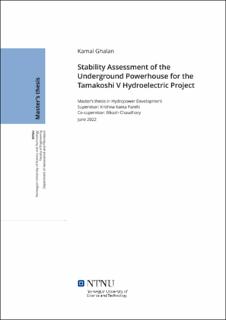| dc.description.abstract | Underground excavation presents several hazards and difficulties, especially when weak and schistose rock masses are involved. Excavated caverns in weak, deformable rock masses with thick rock cover are more prone to instability in the form of deformation. In weak rocks such as shales, schists, phyllites, Lesser Himalayan shales, and Siwalik, as well as in zones of weakness and faults, squeezing is quite common during subsurface outcrop (Panthi, 2006). In the Himalayas, rock masses are highly stressed and brittle due to active tectonic movements. They are unable to withstand high in-situ stress. These rocks are soft and plastic. Mostly, block/wedge fractures and plastic deformation are the cause of instability of these rock masses.
The Tamakoshi V Hydroelectric Project is a cascade system with an installed capacity of 99.8 MW under the 456 MW Upper Tamakoshi Hydroelectric Project. According to NEA (2019), the project is located on the right bank of the Tamakoshi River in Dolakha district, Nepal. Block/wedge failure and plastic deformation analyzes have been conducted to investigate the instabilities that may occur during construction and in the long term at this project. In addition, the power cavern close to the main central overthrust (MCT) of the Himalayas, which may be affected by ongoing tectonic movements, requires a comprehensive assessment of the effects of earthquakes.
This study aims to evaluate and interpret the various methods for assessing block/wedge failure, plastic deformation, and earthquake effects on long-term stability in the underground powerhouse and caverns and optimise support. Wedge failure was evaluated using UnWedge 5.0. Singh (1992), Goel (1995), and Q-system (1993) all used empirical approaches to study plastic deformation. (Hoek & Marinos, 2000), and (Panthi & Shrestha, 2018) used semi-empirical approaches. The analytical technique of (Carranza-Torres & Fairhurst, 2000), known as the convergence confinement method (CCM), was used for plastic deformation analysis and support pressure study. The work includes a numerical analysis using sophisticated 2D and 3D finite element software, namely RS2 and RS3, for both static and dynamic loading, which showed that the supports such as bolts and concrete lining (SFR) yielded to certain extent and kept the deformation to a minimum. The analysis was performed with a critically disturbed zone to determine the size of the failure. The resulting, deformations of up to 0.37 m were observed in the wall of the powerhouse and the transformer cavern. | |
